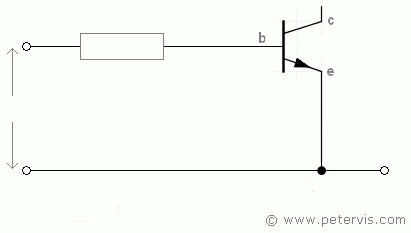Transistor Base Resistor and Hard Saturation

Hard saturation is when the transistor operates in the saturation region under all operating conditions. Remember that the current gain changes as the operating conditions such as temperature, and collector current, change. Hence, engineers usually choose a base resistance that produces a current gain of 10 (hFE=10) to ensure that the transistor goes deep into hard saturation. This article shows in a very simplified way of calculating the base resistance, and it might be useful to beginners and hobbyists.
Example

To calculate a suitable value of the base resistor Rb, we start by calculating the saturation current at the collector Ic(sat). Then, using a gain of 10, we use the gain formula to find the required saturating base current Ib(sat). Finally, armed with the saturating base current, and the input switching voltage at the base, we use Ohm’s Law to calculate the base resistance value.
Step 1: Recognizing Hard Saturation Ic(sat)

When the transistor is in hard saturation, it is conducting fully, and there is no voltage drop across its emitter-collector junctions. In practice, the voltage drop across these junctions is considered negligible. When this happens, the entire supply rail is then across the load resistance, and as you can see, we can then use Ohm’s Law to calculate the current passing through the load resistor. This same current also passes through the collector junction, which we call saturation current Ic(sat).
In this simple example, with simple values, we can see that if the load resistance was 1 kΩ, and the voltage across it was 10 V, then Ohm’s Law (V = I × R) is used to calculate the current passing through it, which is 10 / 1000 = 10 mA. This current also has to pass through the collector and therefore we can establish that Ic(sat)=10 mA.
Step 2: Using DC Gain hFE=10
To guarantee hard saturation we always use the value of 10 for the DC current gain (hFE). At this point, you should recall the basic current gain formula that states that the base current (Ib) multiplied by the gain (hFE) gives the collector current (Ic). hence we can use this to find the required saturating base current Ib(sat).
Ib × hFE = Ic
Ib(sat) × 10 = Ic(sat)
Hence, it follows that:
Ib(sat) = Ic(sat) / 10
Ib(sat) = 0.010 / 10
Ib(sat) = 0.001 A
Hence, in this example, we need a base current of 0.001 A to cause the transistor to go deep into saturation.
Step 3: Calculating Base Resistor Value
Now that we know the required saturating base current, we know that this is also the current that passes through the base resistor. Now all we need to know is the switching voltage being fed to the input. Your circuit might be TTL and feeding 5 V, or perhaps CMOS, feeding 3.3 V. In this example, to make the maths simple, let us say that the switching voltage is 10 V at the input.

When the transistor is in hard saturation, the entire switching voltage (10 V), will be effectively across the base resistor. This is because we consider the voltage drop of 0.7 V across the base-emitter junctions to be negligible.
Since we now know the switching voltage (Vi) across the base resistor (Rb) and the current going through it Ib(sat), we can easily calculate its value.
Hence,
Rb = Vi / Ib(sat)
Rb = 10 / 0.001
Rb = 10 kΩ
This Article Continues...
Transistor Base Resistor CalculatorTransistor Base Resistor and Hard Saturation
Transistor Hard Saturation -- Rule of Thumb
Transistor as a Switch
Standard Resistor Values